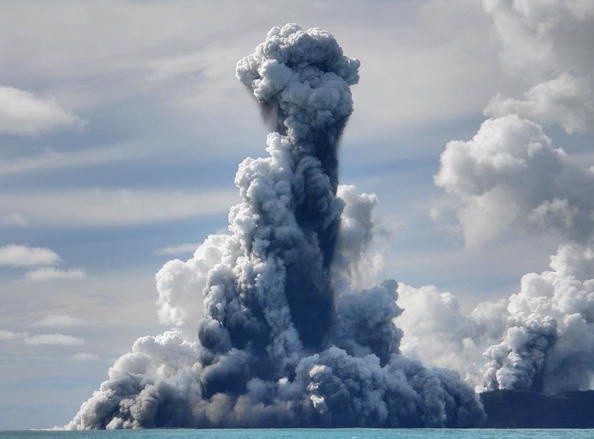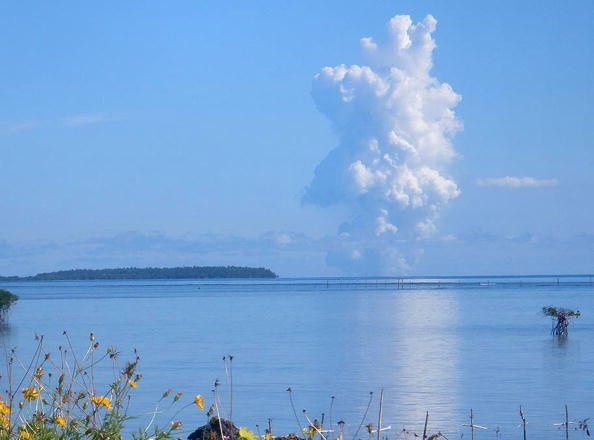Scientists may need years to figure out exactly what happened during the 11-hour eruption that impacted Tonga on January 15 and what it means for future volcanic threats .
According to Nature, the Hunga Tonga-Hunga Ha'apai volcano emitted a cloud of ash that rose high into the sky and prompted a tsunami that damaged houses. The eruption's reverberations spread throughout the world many times.
Impact of Tonga's Historic Eruption

Earth-observing satellites have documented the enormous intensity of the blast, which is contradicting current theories about volcanic eruptions.
Volcano scientists are baffled as to why the cloud it produced rose to such altitudes while emitting far less ash than one might expect from an eruption of this size. And the shock waves that raced across the atmosphere and oceans are unlike anything that has ever been observed in the current scientific age.
More than 100,000 Tonga residents have been displaced as a result of the eruption, which occurred only 65 kilometers from the capital city of Nuku'alofa.
The eruption has claimed the lives of at least three individuals in Tonga. COVID-19 has exacerbated the issue, with the first wave of cases starting after relief ships from other countries arrived.
However, the region is still being shaken by earthquakes, and the volcanic threat may not be finished. Preliminary analysis of ash from the January 15 eruption suggests that it came from a new batch of magma coming from within Earth's crust. Tonga-Kermadec volcanic arc gives it a height of more than 2,000 meters above sea level.
Hunga Tonga-Hunga Ha'apai has been rocked by massive eruptions around once every millennium, with the most recent eruptions occurring between AD 200 and AD 1100. Smaller earthquakes occurred in 1937 and 1988, both in the last century.
Two small islands, Hunga Tonga and Hunga Ha'apai, appeared above the seas at this moment, indicating that the volcano's summit was visible. As soon as the new island appeared, a number of research teams traveled there to collect volcanic ash and rock samples.
How Water Fuel Explosive Eruptions
Due to pressure from the surrounding water, gas bubbles rarely develop and grow explosively in deep-water volcanoes, preventing large-scale eruptions through the ocean surface.
On the other hand, the Hunga Tonga-Hunga Ha'apai volcanic vent that erupted on January 15 was only a few hundred meters deep. Even though it's a short distance from the surface, the erupting lava will nevertheless come into contact with a substantial amount of water.
Flash-heating water to generate steam, which expands rapidly, is a powerful source of energy for exploding volcanoes. Geoscientist Michael Manga of the University of California, Berkeley argues that this method effectively converts the heat energy of magma into the kinetic energy of an eruption.
In addition to eruptions occurring underwater or under snow and ice, there are numerous examples of volcanic eruptions that have included water.
Extremely high eruption plumes have been observed by researchers as well. Hunga Tonga-Hunga Ha'apai, on the other hand, is a singular instance of both things occurring at the same time. He speculates that it could serve as a prototype for a previously unidentified eruption style.

Volcano Ripple Effects
Volcanology may also be reshaped by the eruption of Hunga Tonga-Hunga Ha'apai, which blasted a wide range of waves that reverberated across the waters and into the sky.
The reverberations it sent out over the world are similar to those experienced following Indonesia's 1883 Krakatau eruption, says Rutgers University climate scientist Alan Robock.
All around the Pacific Ocean, even in ocean basins that are thousands of miles away, pressure and gravity waves and tsunami waves were generated by the eruption. Disturbances in the ionosphere, the layer of the atmosphere above the stratosphere, were also observed by GPS satellites, beginning at an altitude of 80-90 kilometers.
The task at hand now is to acquire enough information to complete the puzzle. In the case of an active volcano, seismologists would typically use seismometers to monitor earthquakes in the vicinity.
In Tonga, there are currently no operational seismometers, therefore the huge quakes that have been occurring around Hunga Tonga-Hunga Ha'apai since the eruption of the 15 January volcano have not been tracked in great detail.
According to Cronin, the evidence available suggests that the earthquakes are caused by new magma rising through the crust to replenish the reservoir that was drained by the massive eruption.
Related Article : Scientists: Disastrous Tonga Volcano Eruption 500 Times More Powerful Compared to Hiroshima
For more news, updates about volcano eruption and similar topics don;'t forget to folllow Narure World New!
© 2026 NatureWorldNews.com All rights reserved. Do not reproduce without permission.





